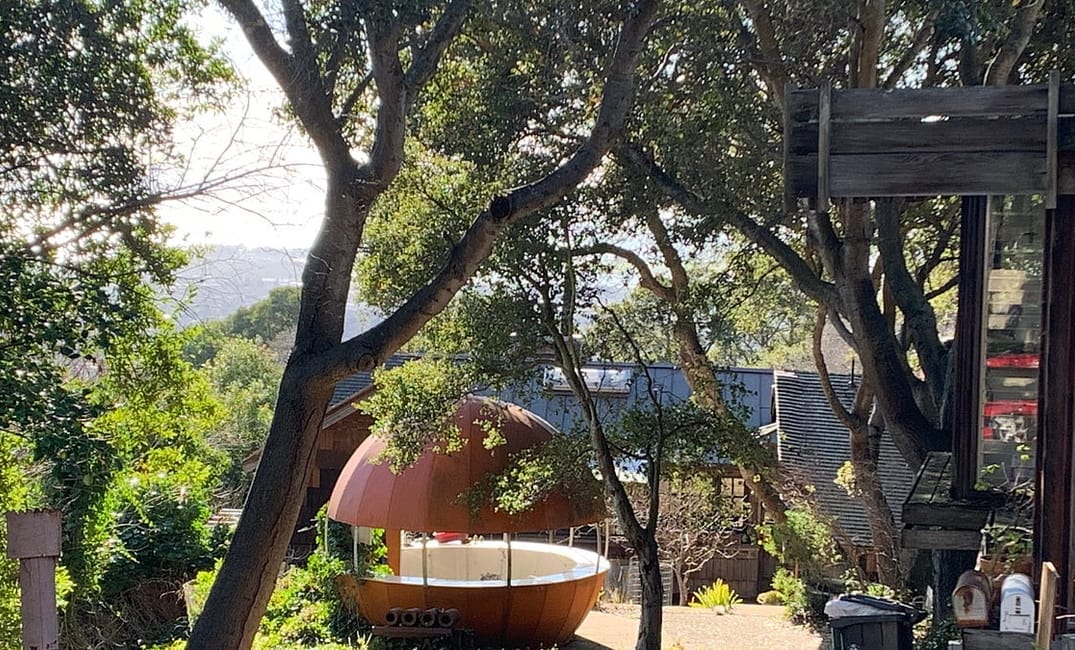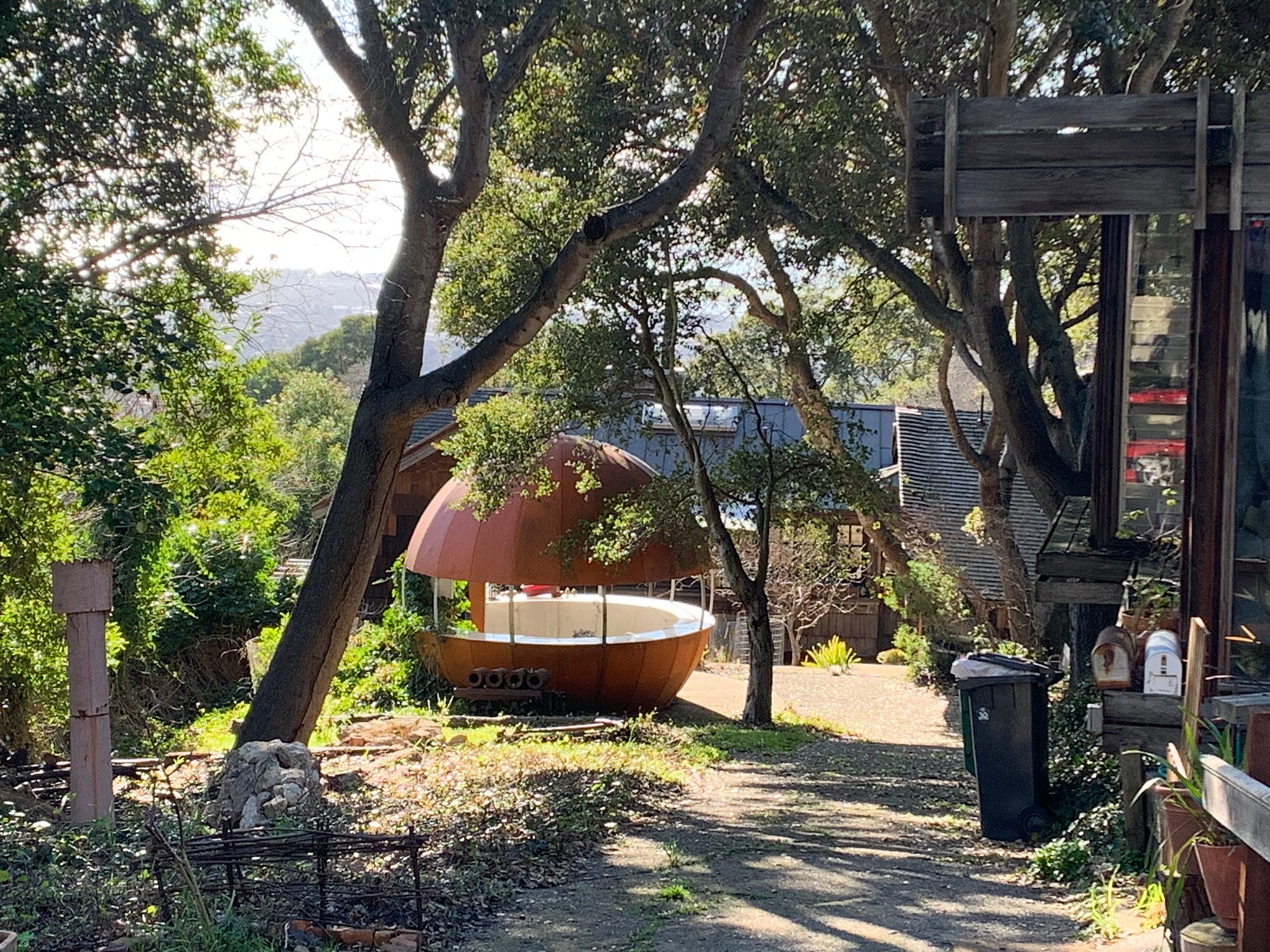
Berkeley has a reputation for weird. It’s also known for political activism, great food, and those smarty-pants at Cal, but the city’s inherent quirkiness pervades its past and present. For the most part, it’s a reputation today’s residents embrace — you may have tried Calicraft Brewing’s Buzzerkeley golden ale or read the top definition of “Berzerkeley” on the ever-trustworthy UrbanDictionary.com: “Berzerkeley will always be a favorite destination for freaks from all over the world.” Well put.
Indexing the innumerable histories, stories, and sites that make up Berkeley’s past, present, and future of bizarre would be truly impossible. The person who has come closest, perhaps, is Tom Dalzell, longtime Berkeley resident and author of the 2006 book Quirky Berkeley (and subsequent volumes). Years ago, Dalzell set upon the goal of walking every path, street, and alley in search of the city’s strangest spots.
The following, therefore, is a nonexhaustive list of 10 places you can visit today to get a feel for the Berkeley Quirk — pulled from personal research, sites I stumbled across while living in Berkeley, and Dalzell’s definitive account.
1. The Vine Street UFO
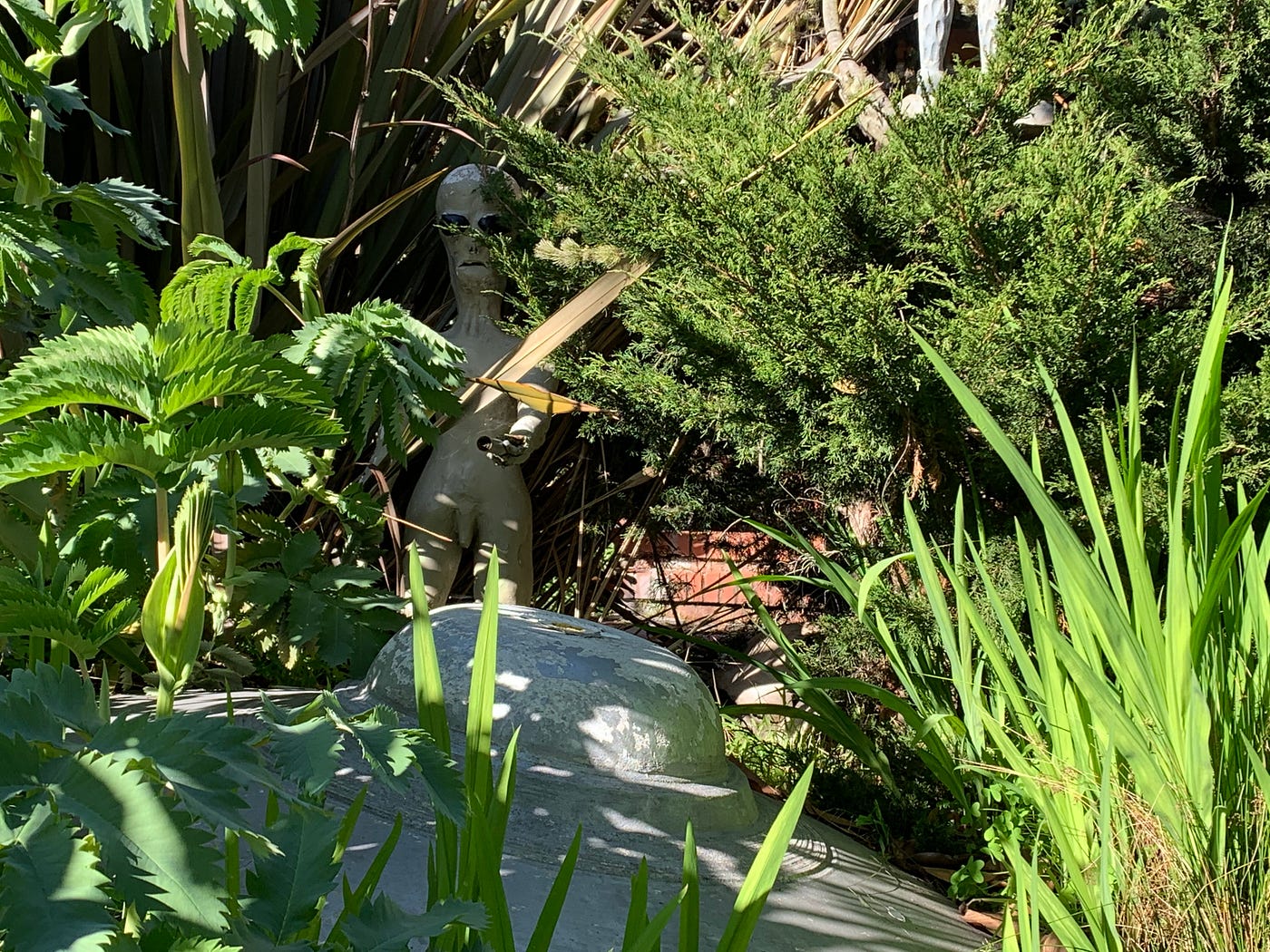
A personal favorite, the Vine Street UFO is a delightfully kitschy front-yard display less than a block from the original Peet’s Coffee on Vine Street.
The scene is tucked into the beautiful home’s greenery: a classic saucer-shaped UFO appears to have crashed among the succulents, the bug-eyed (and well-endowed) extraterrestrial pilot standing with arm outstretched over his downed interstellar craft. At night, twinkling lights enhance the old-school sci-fi movie feel. Don’t miss the “Berkeley or Bust” bumper sticker stuck to the alien ship.
Why is it there? Turns out, Oakland artist Kyle Milligan gifted the installation to the residents, who, it should be noted, have transformed the entire stately home into a shrine for the artistically “quirky” aesthetic.
Where to see it: 2155 Vine Street, Berkeley. It’s in the yard of a private residence, but you can see the UFO display from the sidewalk.
2. East Bay Vivarium
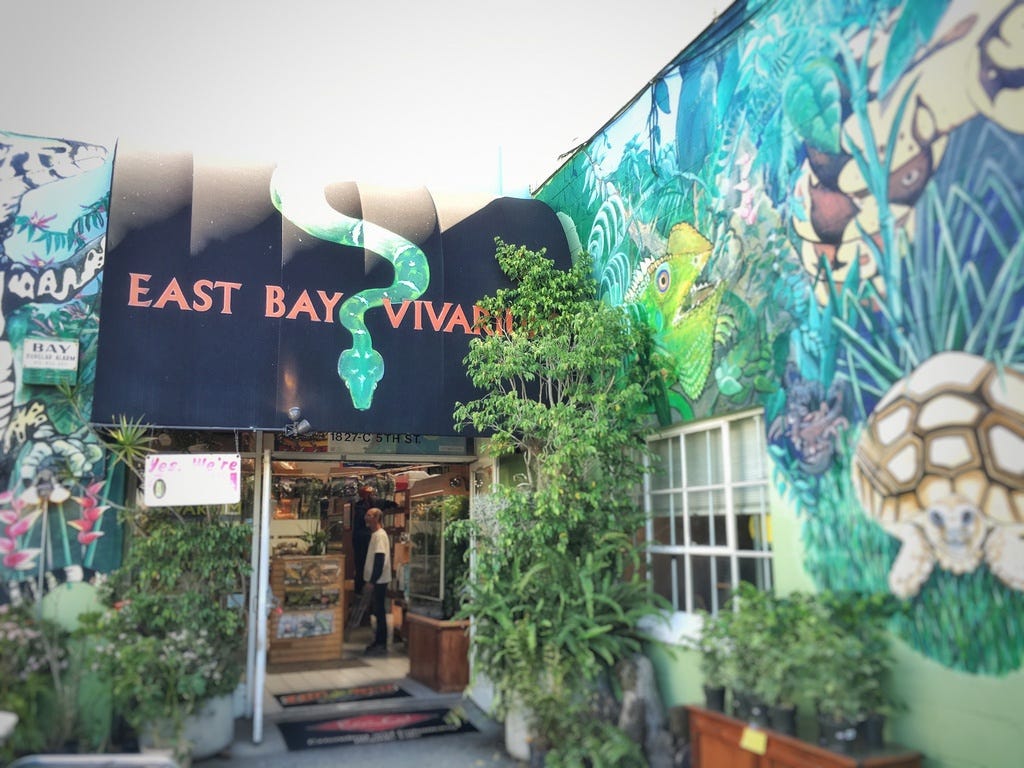
The vivarium, sitting off the increasingly bougie Fourth Street shopping district, is a true gem for anyone looking for offbeat weekend activities or anything with scales. It’s a reptile store, yes, but it’s so much more.
Turn the corner toward the entrance, and you’ll see a top-to-bottom reptile-themed mural covering the entire storefront. You’re in the right place. Walk past the outdoor turtle pond and through the entrance, and you’ll find yourself in a 10-foot-high labyrinth of habitat enclosures. At every turn, you can peer at fascinating creatures: the tiniest pencil-thin snakes, hand-sized tarantulas, neon green frogs, and Lemondrop, a stunning 15-foot albino reticulated python who previously lived at the Cal Academy of Sciences.
According to the vivarium’s website, it’s the “largest and oldest retail herpetological store open in the East Bay since 1970.” Although it’s a pet and supply store at its core, East Bay Vivarium is just as enjoyable for people sans reptilian pets. Adults and kids alike can easily spend an hour gazing at a chameleon’s calculated stroll down a branch or the distinctly prehistoric sight of a snoozing monitor lizard.
Where to see it: 1827-C Fifth Street. Open 11 a.m. to 7 p.m. on weekdays; 11 a.m. to 6 p.m. on weekends.
3. Indian Rock
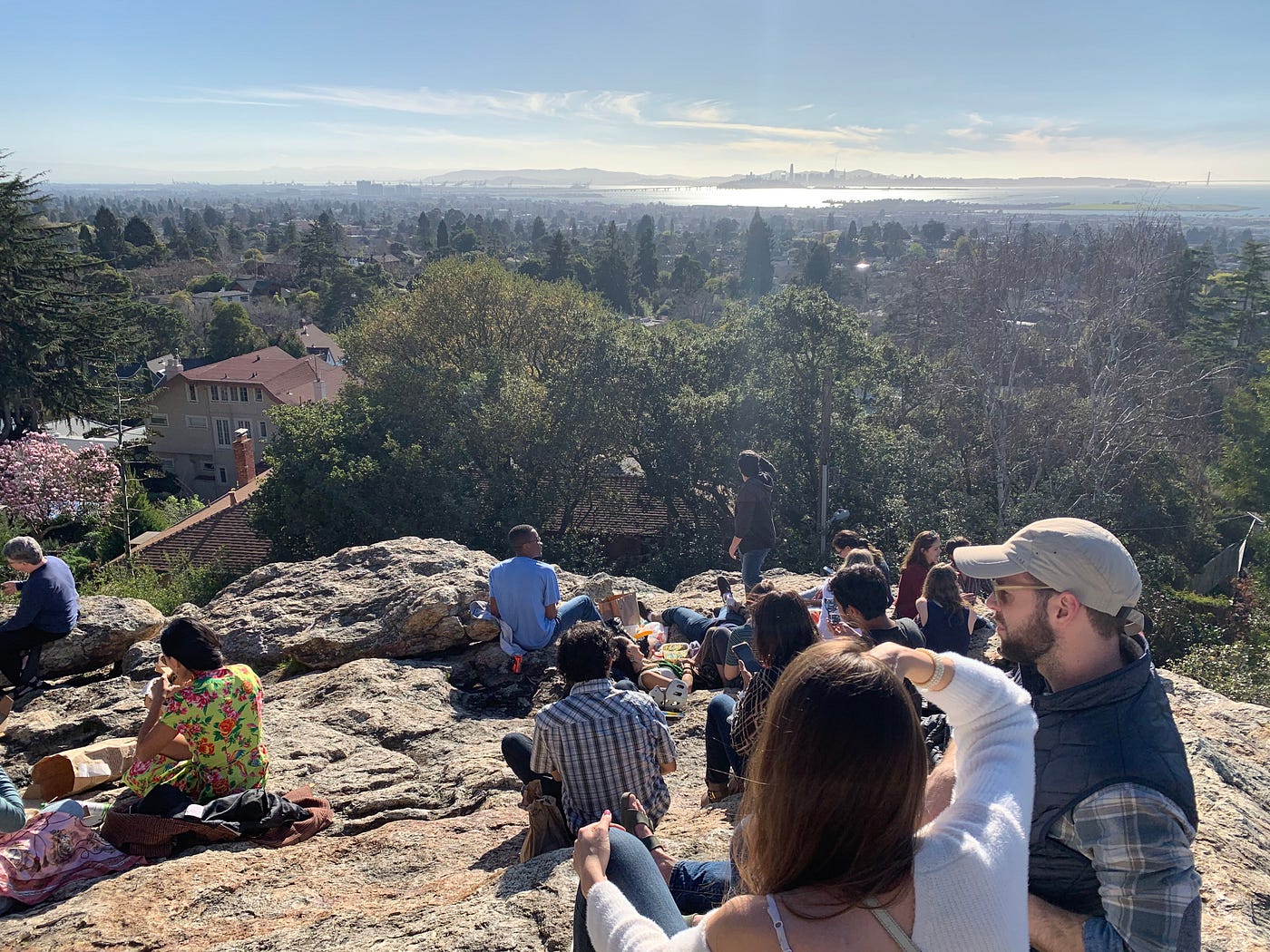
Indian Rock park is honestly just a big ol’ rock, smack dab in a residential neighborhood of Berkeley Hills. Visitors can clamber around the outcropping for rock climbing practice or simply walk up the steps carved into the rock face for a stunning view of the bay and a perfect picnic spot. If you go after dark on a mild night, you’re likely to find couples, friends, and solo viewers taking in the lights of the bay with you; clouds of pot smoke and the chill tones of a steel drum are frequent elements of the tableau.
The massive rock was “gifted” for Berkeley’s public use by a real estate company during the neighborhood’s development. According to the city’s website, David Brower, the “father of modern rock climbing,” learned his skills at this very rock. The rock’s history, of course, goes back much farther. Native Ohlone people used the rock for grinding acorn flour with pestles, leaving depressions in the rock you can still see today.
Where to see it: 950 Indian Rock Avenue at Shattuck Avenue. Park hours are 6 a.m. to 10 p.m. daily.
4. Eugene Tssui Fish House

This otherworldly home on Mathews Street is, according to Dalzell, “the least-expected and probably the most-photographed architectural design in Berkeley.” The structure was designed by accomplished Emeryville architect Eugene Tssui, who is just as fascinating as the house in his own right.
This particular design of Tssui’s is reportedly inspired by the tiny but mighty tardigrade, a nearly microscopic, nearly indestructible animal. Without knowing that specific design origin, one might think the house resembles the home of a mythical sea god if they had their own version of suburbs in the deep. The place quite literally sparkles, thanks to crushed abalone shells pressed into the exterior. Its official name is apparently Ojo del Sol or Tai Yang Yen (the Sun’s Eye) as a nod to the prominent oculus window feature.
Tssui’s imaginative vision was not met with open arms on the distinctly normal Mathews Street. As Dalzell reports in Berkeleyside, “Tssui credits then-mayor Loni Hancock with stepping in and putting an end to the debate in the name of freedom of thought and design.” Good on Hancock.
Where to see it: 2747 Mathews Street. This is a private residence but viewable from the sidewalk.
5. The wishing well

On the 1700 block of Channing Way, a wooden wishing well has stood in the shade of trees along the street for just about 50 years. Residents give and take items for free through the grassroots mechanism of the well. On any given day, you can find an array of random household items in and around the well: clothing, kitchen items, arts and crafts materials, and whatever else locals have decided to offer up to their neighbors.
According to the Berkeley Daily Planet, local lore holds that the well was installed in the 1960s “to keep alive the spirit of love and sharing.” In 2006, the city council considered removing the free box after receiving a petition from some nearby residents. Proponents of the well, calling themselves the Well Wishers, gathered more than 600 signatures in an impassioned effort to preserve the neighborhood tradition. Today, the well remains and is now named the Dona Spring Wishing Well in honor of the Berkeley city council member and local activist who advocated for saving the well, which was in her district. On a recent weekend drive-by, the well offered up books, a high chair full of lightly used shoes, a deck of playing cards, and a jogging stroller, to name just a few of the donated items.
Where to see it: 1700 block of Channing, on the north side of the street between Roosevelt and McGee.
6. The giant orange

Among the trees in Berkeley’s hills, a giant metal orange rests in a backyard on Spruce Street. As Dalzell writes, the orange is a relic from the first half of the 20th century. Between the 1920s and the 1960s, giant oranges dotted California highways, attracting motorists for a cold drink of orange juice. This particular antique orange was reportedly in use as a chicken coop before the Berkeley residents saved it from that smelly fate, returned it to its sunny glory, and perched it in the backyard of their home overlooking the bay.
You can spy the orange from the sidewalk, and apparently the owner still enjoys throwing parties in it occasionally. I’m assuming the screwdriver is the drink of choice.
Where to see it: 722 Spruce Street. It’s in the backyard of a private residence but viewable from the street.
7. Open mic night at Missouri Lounge

Wander by the corner of San Pablo and Parker on a Wednesday night, and you’ll catch the scent of bacon and cigarettes wafting over the fences surrounding Missouri Lounge’s back patio. If that doesn’t tempt you, the screech of an electric guitar getting plugged in should clue you in to the real treat: open mic night.
Missouri Lounge is a local dive that has claimed its corner for several decades. The red wooden bar’s exact origin story is something of a legend. Rumor has it that it’s named Missouri Lounge because the previous owner, Argentina “Argie” Shepherd, worked on the USS Missouri Liberty ship during WWII. But as KQED reported, Shepherd didn’t actually work on a ship of that name. However, she did help build Liberty ships during the war and was a total badass who bought the bar in 1950 for $15,000, then set the opening time as 6 a.m.
On Wednesdays, the bar’s local ties and core contingent of regulars really shine. Once open mic night kicks off, you’re bound to see the loyal patrons perform unique acts honed over years of weekly performances. There’s always a college student or two strumming an acoustic guitar, and occasionally a spoken word artist steps up to the plate as well. All this Berkeley excellence can be enjoyed with a beer and BLT in hand.
Today, a semi-constructed multistory building looms over the lounge on two sides. It’s an apt juxtaposition between old and new. Mixed-use behemoths hem in on all sides, but Missouri Lounge abides.
Where to see it: 2600 San Pablo Avenue. Open 12 p.m. to 2 a.m. Open mic nights every Wednesday.
8. The Tiny Tilden Post Office

In December 2013, Lea Redmond built perhaps one of the cutest quirky spots in Berkeley: a teeny-tiny post office in the knothole of an old tree. Redmond is the founder of Leafcutter Designs, which also runs the “world’s smallest postal service” and a storefront in Oakland. She reportedly created the fairy-sized post office as a thank-you to a writer, and it immediately delighted passersby who discovered the miniature office.
The original setup included a tiny lamp, mailbox, and desk complete with a minuscule vase of flowers and teeny letters (part of their specialty at the world’s smallest postal service). At first, it was discoverable only to those perceptive few who spotted it among the trees along the Curran Trail, but Redmond eventually put out a map to encourage more people to enjoy it. The post office’s furniture and decor have evolved over the years, but as Redmond writes on her website, she’s pleased to find that “for every item that manages to wander off, something else new and remarkable seems to appear at the same time.”
Where to see it: Near the intersection of the Curran and Wildcat Gorge Trails. Follow the map Redmond provides on her website.
9. Backyard hot tub
The “secret” Essex hot tub of Berkeley has sparked both public fascination and, recently, criticism, but the fabled locale has held a spot in Berkeley lore for decades.
As SFGate reported after an interview with the unidentified owner, he built the hot tub in the 1970s when he was disappointed by the lack of natural hot springs in town. He left it open for public use when he was home but eventually decided to install a code combination lock for crowd control a few decades back. The working codes, like the tub’s exact location, continue to spread by word of mouth.
The prevailing dress code: nothing. Visitors skinny-dip among the redwoods. Twenty years ago, the press reported that 30,000 bathers had visited the tub since its inception. That number is likely much higher today, but it may not currently be open to the naked public. There existed a long-running rule that men had to be accompanied by a woman in order to enter. That guideline recently drew online criticism for transphobic policing; at the time that post was made, the hot tub was reportedly closed for an indefinite period.
Personally, I’ve never tried to locate the tub, so I can’t say whether it’s currently open for nude soaks under the redwoods, but its legend lives on in the form of a line on many locals’ bucket lists.
Where to see it: In a residential backyard on Essex Street. The exact location is shared by word of mouth.
10. The storybook neighborhood of Normandy Village
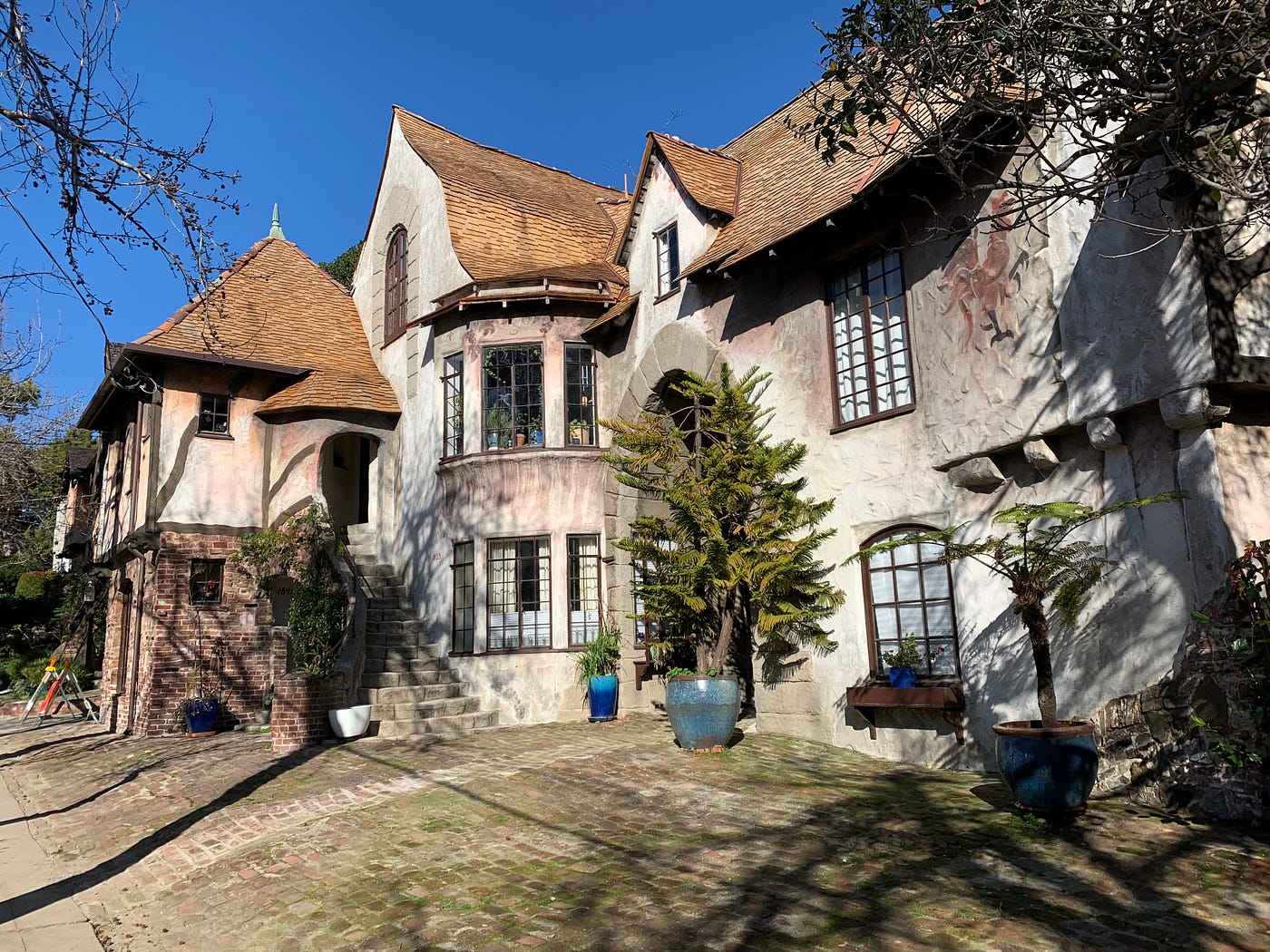
If you turn up Spruce Street from Hearst Avenue, you may think you’ve been transported to Old Europe. It seems within the realm of possibility that the villagers from Beauty and the Beast will suddenly burst through the doors, holding baskets of bread and yelling, “Bonjour!” Normandy Village — or Thornburg Village — is an apartment complex built in the late 1920s in the style of a storybook village.
Its intricate carved fences, curving staircases, rounded turrets, and wooden gargoyles make it an altogether baffling site within walking distance of the Cal Campus. It was developed by a 25-year-old Californian named John Thornburg, based on designs by William Raymond Yelland, an Oakland architect and World War I veteran. According to a 1927 article in the Oakland Tribune, Thornburg envisioned it as a self-contained “village,” complete with cafés and shops among the residences. Zoning issues meant that was never to be, but today it’s a Berkeley Historical Landmark and remains a residential apartment building.
Where to see it: 1781 Spruce Street. It’s a private residence, so you can’t walk inside the complex, but you can view plenty of the features from the sidewalk.



